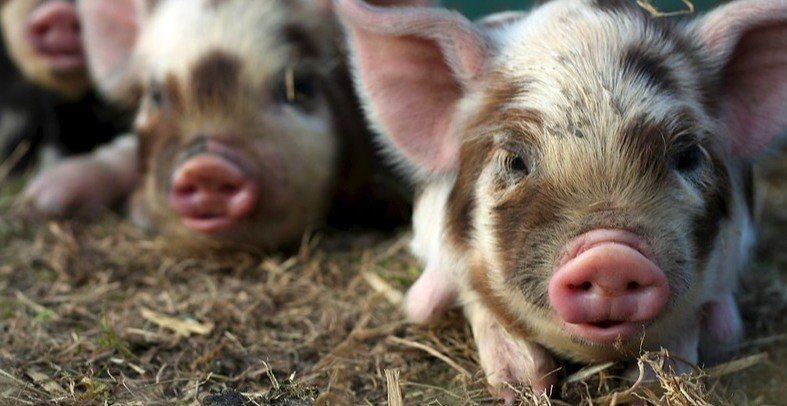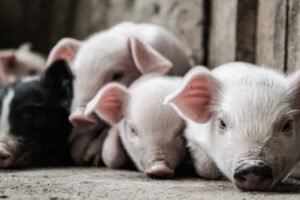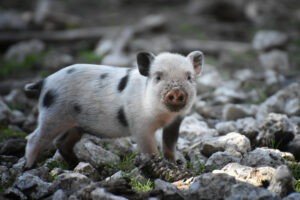Kunekune pigs do very well on a diet of grass, fresh fruit, and vegetables. They are different from commercial pigs in that they do not need high levels of protein.
Kunes need around 16% protein, and in comparison, it is quite less. The fiber requirement is also much more than commercial pigs. Kunekune pigs do well on grass and vegetables in summers, in autumn this can be complemented with apples.
In the winter when the grass loses its nutritional factor, it can be mixed with protein sow and grass pellets, and water. This amount will differ from the condition of the pigs.
What is Kunekune pig’s diet?
Due to their sweet nature and miniature size, Kunekune pigs make the ideal addition to your farm or ranches. These pigs originate from New Zealand and the number of people keeping them as pets is increasing.
Bearing in mind different types of grass quality and quantity, it is vital to provide the right feed to meet the precise dietary needs of Kunekunes. They incline to hold on to their weight, so they need high fiber and low protein pig feed such as for a Pot-bellied Pig Food. A complete feed from Pot-Bellied Pig Food is balanced enough for the daily feed of your Kunes. This ensures your pigs are getting all the essential vitamins and minerals.

Kunekunes are a grass foraging pig and can handle a high fiber diet. Adult Kunekunes can maintain body condition on a good quality pasture. But if the pasture quality is not that high, it is recommended to supplement their diet with other vitamins and minerals. If you don’t want to put your pig on a commercial ration, be cautious that the complement is of sufficient quality for what the pig needs.
Pregnant and lactating sows should always be fed at a higher quality feed, as their nutritional needs are greater. For young pigs, a good quality supplement should be used up until about 9 months of age during their growing phase.
Different foods contain diverse ratios of protein, carbohydrate, and fiber: pasture comprises about 3% protein, bread up to 9% protein but with higher carbohydrate, potatoes 0.5% protein, milk 4-5% protein. Cheese is also a superb supplement, but like milk can cause diarrhea because of greater fat content.
The key commercial pellet feed varies from 12 to 17% protein, but not all comprise the essential vitamins and amino acids of a nutritionally complete food.
The recommended rate of feeding commercial pellets when some pasture is available:
- Adult boar or sow – 1 to 1.5 Kg per day
- Lactating sow – 1 to 1.5 Kg + 0.2Kg/piglet/day
- Piglets 2-4 months – 0.5 Kg per day
- Pigs 4-9 months – 0.75 Kg per day
Pigs must be fed twice a day when needing to be supplemented, and have easy access to clean drinking water. Adult sows can drink up to 5-litres of water a day during lactation, predominantly during hot weather.
Creep feed is not usually provided for Kunekune piglets if the sow is not producing adequate milk.
How much feed do Kunekune pigs need?
Kunekunes should be given approximately 1-2% of their body weight in pelleted form along with free access to grass or hay.
The feed should be divided into two feeds a day and could be served in a trough or scattered in their enclosure. Scattering the pellets permits your pigs to display natural foraging behavior and could help extend feeding time.
What treats can you feed your Kunekune pig?
Fruits and vegetables can be given to your pigs as extra treats. These additional treats should be provided between meals to keep your pigs engaged. As with any delicacy, the quantity fed should be kept to a minimum and should be subtracted from their daily allowance of feed.
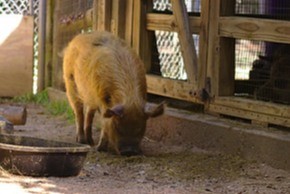
Due to the outbreak of Foot and Mouth in 2001, the law is in place making it unlawful to use kitchen waste. This means any kitchen leftovers, such as fruit and vegetable peels or pet food, cannot be provided to your pigs.
Along with providing a balanced feed, pigs should have free access to clean water and the ability to roam. Water helps with hydration and maintains their body temperature, especially in warm weather when they enjoy wallowing.
What is the Optimal Diet for Kunekune Pigs?
For several years, farmers have been working diligently to optimize their pork production. The weight range goal for pigs is around 175-200 lbs. by a year old.
This all depends on the genetics of a specific pig breed because genetics does not always give you the expected result. It’s as much about knowledgeable breeding choices as it is chance. Many times people just give up in frustration.
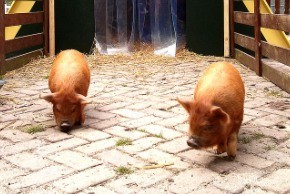
Some people are kind enough to share their diet results because it is always a good practice to attempt to help others and be transparent. After all, if someone is obtaining good results, it’s smart for them to share how they do it for the greater good.
I have faith in the greater good and that we are all better off, including the breed, when there is transparency in information.
Some of the data I have collected on how to optimally feed your kunekune pigs is as follows.
I hope this helps you in feeding your Kunes better.
But first, some feeding rules to live by…
1. Kunekune pigs are not ruminants but omnivores.
2. Your growing pig needs more food and nutrition than adult Kunes.
3. Your growing pig’s body condition in its first year of life should be round but not too chubby.
4. Growing pigs unquestionably need a complete feed with the necessary levels of vitamins, minerals, and amino acids.
5. Growing pigs require protein complemented higher than 16% for optimal growth.
6. The goal is not overweight pigs. The goal is for pigs with a healthy growth rate.
7. Feed your pigs a variety of foods, but don’t overdo fruits or grains or dairy.
8. Eggs can be given a few times per week. Either raw or boiled, eggs are a treat.
9. Whey is perfect for Kunes, in moderation. So you can occasionally give this to them.
10. Bread should be fed in moderate quantity and not the main food source.
11. Avoid sweets and other sugary treats.
12. There is no set magic amount that you should feed your kunekune pig. Pigs are all metabolically different from each other. You should feed their condition. Start with a set amount and watch your pig’s condition. If he is too heavy, cut back, and too thin, Increase the diet.
13. Feed Kunekune pigs things like acorns, wild grapes, bugs, and grubs, or other forests/pasture goodies that a pig might come across in the wild.
With that being said, your pig’s core diet for your Kunekune pig should consist of a completely balanced feed, high-quality hay, pasture/produce/alfalfa pellets or cubes, fodder, etc.
A good combination for Kunekune pigs is Nutrena Country Feeds 16% grower pellet along with a local mash with added vitamins, minerals, and increased lysine. Soak these up for an hour or so. Piglets up to 9 months of age have their feed top-dressed with the Southern States 40% protein supplement, to bring their protein to approximately 18-20%.
Also, remember that you should always follow
· Fresh produce is given as available
· Fruits are limited
· Eggs are an occasional treat
· Alfalfa cubes, alfalfa hay, alfalfa pellets are used when pasture is scarce
· All pigs get high-quality horse hay as bedding
· Beet pulp is great as a filler, to add bulk and fiber to the diet of a pig who you want to lose weight without feeling hungry. Small amounts of soaked beet pulp can be given to all pigs if desired.
· Whey is wonderful and is an excellent treat.
But none of this is a guarantee for hitting your goal weights, but it is a start. I find that Kunekune pigs eat more than most are led to believe that they eat. Our younger pigs eat heartily, especially for their first year. They are not overweight, nor are they structurally strained.
Kunekune pigs vary in size and growth rates and there are no guarantees that a piglet out of fast-growing parents will also have fast growth. But there’s an increased likelihood, especially if properly and amply fed.
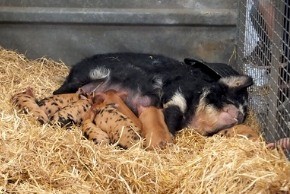
Now the question is how much do you feed your Kunekune pigs? Youngsters up to 4 months old get should be fed up to a 12-ounce scoop of food per day. Observe your pig from starting point and adjust the diet as per their growth. A 4-8-month-old Kunes might eat 1.5-2 scoops. I’d say that adults eat around 1-1.5 scoops per day when in optimal condition. This is just an example- and not written in stone. You need to sample various feed rates with your pigs based on what you feed… but most of all, feed your pigs to condition. Healthy conditions, not to make them overweight or obese.
Do I believe that adults can thrive solely on just pasture? Yes, they can, but people don’t follow this year around or even part of the year. I also know that pigs are omnivores and appreciate variety.
How to feed KuneKune Pigs?
First, let me say that grazing is extremely important for this breed. So important that as my herd grew we purchased another farm so that we could provide our pigs with more grazing. In Virginia, grazing is not available all year long.
We believe that their grazing alone is not quite enough except for maybe your pigs that are set aside for providing your family with pork. Therefore, we do give our pigs grain. Happily, twice a day we feed Blue Pig and Sow after much trial and error at the beginning of our breeding days. I found that our piglets developed and matured better on Blue Seal Pig and Sow.
We have also used hydroponic barley for many years and did so, all year-round. When researching hydroponic barley, we ran across many different options that we could purchase. Being new to this new method spending $2500 and up did not appeal to me at all. So, what did I do? Well, I came up with a system that worked very well for us for less than about $200. So we feed hydroponic barley fodder which the pigs love and is great nutritionally speaking as well as economically.
While your piglets or younger pigs are developing they must be provided with grain to develop and mature correctly. Grass-fed only the KuneKunes stay slimmer and their snout length seems to get longer. This usually happens to they can root. Remember a short upturned snout is not prone to root. The longer snouts are much more effective at being able to turn the earth and eat the roots of the grass and discover Grubbs.
KuneKune means “fat and round” and our KuneKunes eat not only Blue Seal Pig and Sow and Hydroponic Barley but, lots of fruits and veggies as well. How would you feel eating sprouts every day…day in and out? Well, our dear KuneKunes prefer a variety of foods as well. Just remember your KuneKune needs 16% and under of grain.
How much space does a Kunekune pig need?
No products found.
Due to their natural grazing and rooting behavior, Kunekunes require adequate space to roam. Recommendations are for 4-6 pigs per acre, however, it may be beneficial to look at dividing up the land to allow for pasture rotation and the introduction of hard standing areas and shelters on the land to help prolong the grazing available.
Feeding your Kunekunes the Pot-Bellied Pig Food from the Smallholder Range, combined with the right management, will provide you with many years of enjoyment in caring for your pigs knowing you are providing them with everything they need for a balanced diet.
Last update on 2023-07-31 / Affiliate links / Images from Amazon Product Advertising API

